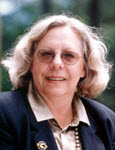AAI President's Message

Susan L. Swain, Ph.D. (AAI President, 2004–05)
I assumed the AAI helm at a challenging time for biomedical research and for those who would choose life sciences research for their career. On the positive side, biomedical research continues to be a priority for the American public and the Congress, where it attracts support from politicians of all stripes. NIH is being funded at an all-time high, with its budget more than doubling in the last 6 years alone [to an expected Fiscal Year 2005 budget of more than $28 billion]. The budget for the NIAID, which funds the work of so many immunologists, has skyrocketed since 1986, increasing from $625 million to $6.3 billion in Fiscal Year 2004. And through the work of AAI and many of its members, there is increasing understanding among elected officials and the public that immunology is at the heart of protection against infectious diseases, autoimmunity, and cancer, and is essential to advancing needed biodefense research.
Very good news, you might say. But very real challenges lie ahead, and our community needs to face the future with a plan. As AAI President, I hope to spark the debate needed to begin addressing some of these challenges.
With the very large budget deficit, ongoing military action, and decreased tax revenue (due to tax cuts), funding for biomedical research is leveling off and may even decline (when adjusted for inflation). Because there may not be enough funding to support even existing labs and investigators, much less new ones, we would be well-served to consider the way we do science. The model of research we currently use is driven by graduate students and postdoctoral fellows and produces an exponential increase in scientists. It is a system in which successful PIs train multiple young scientists (in the ballpark of 4-10 or more), requiring large increases in research support over time. We have been able to accommodate this growth thus far because of steady increases in NIH support and pharmaceutical biomedical research. As the research budget levels off, however, there will not be enough jobs to accommodate this model of science. We need to consider alternate models that don't depend on labs staffed by graduate students and postdoctoral fellows, and that can survive the likelihood of fewer and/or smaller grants for the foreseeable future.
This is not to say that we should give up on efforts to encourage greater funding of biomedical research or reduce our commitment to educating Congress and the public to the great benefits it can have. Quite the contrary – as many national priorities compete for limited dollars, it is even more important that we remind Congress of the crucial work that we do and of the urgency of a sustained national investment in biomedical research. But even as AAI continues its work with Congress, AAI members need to be realistic – there will be no superinflationary increases – to ensure that our work, our progress, and our success will continue.
In addition to smaller increases in federal research funding, PIs – and potential PIs – face additional challenges.
First: NIAID funds which were appropriated for one-time costs for construction were converted in the subsequent year (FY 2004) almost entirely into contracts, dashing hopes that these funds would be deposited into the RO1 pool.
Second: The NIH Roadmap, the signature program of NIH Director Elias Zerhouni, will this year divert $237 million (an increase of $109 million over FY 2004) out of the general NIH budget and direct it towards multidisciplinary and team research. In addition to the diversion of these funds, this new way of organizing research teams raises many questions about the traditional career path of scientists, including how to evaluate scientists (for tenure and awards), how to compensate scientists (salary, benefits), and how to publish scientists' research [determining the relative contribution of the various author(s)].
Third: Much of the recent (and enormous) increase in NIAID funding has been directed to biodefense research, an area that historically was limited in scope and often unrelated to the leading research in immunology. Today and for the foreseeable future, many young scientists who want to be funded by the government will wisely consider tailoring proposed research projects to the biodefense area, where funding is more plentiful. If the smart young researchers do this, who will take over the projects of retiring PIs who investigate less targeted basic questions, questions which have often yielded the unexpected discoveries that have brought us all to where we are?
Exploring these questions and finding answers that address our community's needs are my top priorities for this year. I hope you will join me through your active involvement with AAI.